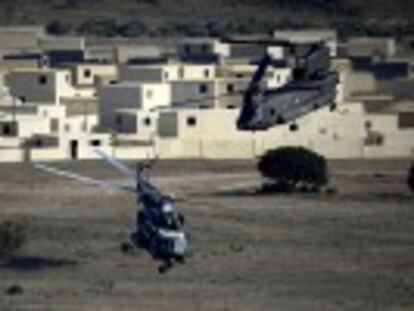Spanish troops deploy near Russia with orders to “avoid provocation”
Spain brings powerful contingent to NATO deterrence mission in Latvia, near the Russian border
The Spanish army’s Leopard combat tanks had never participated in a foreign mission until now. And not since the times of the Blue Division – a unit of Spanish volunteers who served with the German army on the Eastern Front during WWII – have Spanish troops been this close to the Russian border: just 200 kilometers away.

Under NATO’s umbrella, a tactical subgroup made up of 300 troops and 80 vehicles from the western Spanish area of Badajoz has begun deploying at Ādaži military base in Latvia. The guidelines are clear: “Keep a defensive profile and avoid provocations.”
“It’s a defensive mission, and above all one of deterrence,” said General Francisco José Dacoba Cerviño, head of the Extremadura Brigade, which is contributing the bulk of the troops, in a conversation with EL PAÍS.
If Russia were to attack, troops would have to contain the first advance until reinforcements arrived
“Following the annexation of Crimea [in 2014], the Baltic states and Poland asked for a permanent NATO presence on their territory,” he adds. “The answer to their concerns, approved at the Warsaw summit of 2016, was an unequivocal sign of solidarity and commitment with all our allies. If one of us is attacked, we are all under attack.”
The Spanish troops will join a tactical battlegroup made up of around 1,000 servicemen and women led by Canada, and currently with the participation of Poland, Italy, Slovenia and Albania. There are three other battlegroups stationed in Estonia (under UK leadership), Lithuania (led by the Germans) and Poland (under the United States). In total, around 4,000 troops from 16 countries are participating in NATO’s “Enhanced Forward Presence,” which aims to reinforce deterrence and defense strategies on the Alliance’s eastern and southeastern borders.
The battlegroup will carry out exercises in September and possibly in October, said the Spanish general.

Unlike other missions, however, Spanish troops will not be patrolling the area this time. Instead, they will simply prepare themselves for action.
“All our activities, maneuvers and target practices will be announced ahead of time, so nobody can claim that they hadn’t been warned. We expect reciprocity from the other side,” said the general, alluding to Russia.
“We have clear instructions to keep a defensive profile, avoid provocation and not come near the border.”
Although less numerous than Canada’s own contribution of 450 troops, General Dacoba said that the Spanish contingent is the strongest “in terms of capacity and power” of all the groups being deployed in Latvia.
The mission guidelines are clear: keep a defensive profile and avoid provocations
Spain is sending six Leopard tanks and 14 Pizarro tanks, which are superior to the Polish PT-91 (which is based on the Soviet T-72) and to the Piranha and Freccia armored vehicles contributed by Canada and Italy.
A Spanish commander will be the number-two official in command, and another will be in charge of training. A Spanish captain will head the sapper unit. Spain is also contributing 12 tracked armored personnel vehicles, support weapons (including mortars and Spike anti-tank guided missiles) and drones.
Dacoba is not contemplating the theory of a Russian attack on Latvia, but he admits that, were one to take place, the troops stationed there would have to contain the first advance until reinforcements arrived. “In order for deterrence to work, it has to be credible,” notes Dacoba. “Otherwise, it could have the opposite effect.”
English version by Susana Urra.
Tu suscripción se está usando en otro dispositivo
¿Quieres añadir otro usuario a tu suscripción?
Si continúas leyendo en este dispositivo, no se podrá leer en el otro.
FlechaTu suscripción se está usando en otro dispositivo y solo puedes acceder a EL PAÍS desde un dispositivo a la vez.
Si quieres compartir tu cuenta, cambia tu suscripción a la modalidad Premium, así podrás añadir otro usuario. Cada uno accederá con su propia cuenta de email, lo que os permitirá personalizar vuestra experiencia en EL PAÍS.
¿Tienes una suscripción de empresa? Accede aquí para contratar más cuentas.
En el caso de no saber quién está usando tu cuenta, te recomendamos cambiar tu contraseña aquí.
Si decides continuar compartiendo tu cuenta, este mensaje se mostrará en tu dispositivo y en el de la otra persona que está usando tu cuenta de forma indefinida, afectando a tu experiencia de lectura. Puedes consultar aquí los términos y condiciones de la suscripción digital.
More information
Últimas noticias
Maduro pleads not guilty before the federal court in New York: ‘I am still the president of Venezuela’
A new test can detect Alzheimer’s from a finger prick
UN team enters Sudanese city of El Fasher after paramilitary massacre: ‘It’s like a ghost town’
A recipe for resistance: Indigenous peoples politicize their struggles from the kitchen
Most viewed
- Gilles Lipovetsky: ‘If you want to live better and fall in love, take Prozac, don’t look to philosophy’
- Alain Aspect, Nobel laureate in physics: ‘Einstein was so smart that he would have had to recognize quantum entanglement’
- Maduro’s downfall puts China’s relationship with Venezuela to the test
- Why oil has been at the center of Venezuela-US conflicts for decades
- Alvin Hellerstein, a 92-year-old judge appointed by Bill Clinton, to preside over Maduro’s trial in New York











































